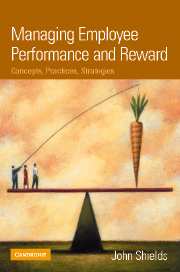Book contents
- Frontmatter
- Contents
- List of figures and tables
- Foreword by John Egan
- Acknowledgements
- Introduction: Setting the scene
- Part 1 The fundamentals
- Part 2 Performance management in action
- Part 3 Base pay and benefits
- Part 4 Rewarding employee performance
- 14 Overview of performance-related rewards
- 15 Merit pay for individual performance
- 16 Recognition awards
- 17 Results-based individual incentives
- 18 Collective short-term incentives
- 19 Collective long-term incentives
- 20 Executive incentives
- Case study. Beyond the hard sell: Performance incentives at Southbank
- Part 5 Fitting it all together
- Model responses to case studies
- References
- Index
18 - Collective short-term incentives
from Part 4 - Rewarding employee performance
- Frontmatter
- Contents
- List of figures and tables
- Foreword by John Egan
- Acknowledgements
- Introduction: Setting the scene
- Part 1 The fundamentals
- Part 2 Performance management in action
- Part 3 Base pay and benefits
- Part 4 Rewarding employee performance
- 14 Overview of performance-related rewards
- 15 Merit pay for individual performance
- 16 Recognition awards
- 17 Results-based individual incentives
- 18 Collective short-term incentives
- 19 Collective long-term incentives
- 20 Executive incentives
- Case study. Beyond the hard sell: Performance incentives at Southbank
- Part 5 Fitting it all together
- Model responses to case studies
- References
- Index
Summary
Performance pay plans that focus on recognising and rewarding short-term performance – that is, performance over a period of a year or less – fall into one or other of two broad categories: those that focus on assessing and rewarding individual performance; and those that focus on rewarding the collective performance of business units, work groups and/or teams. Having now considered the main options and techniques associated with rewarding individual performance, in this chapter we consider short-term incentive (STI) plans of a collective nature. We begin by outlining the general rationale for such plans and by overviewing the four main plan types: profitsharing, gainsharing, goalsharing and team incentives. Subsequent sections explore each of these four plan types in more detail, noting the advantages and disadvantages of each. Consistent with the approach taken in earlier chapters, a final section considers the circumstances in which each approach would be most and least appropriate.
Collective incentives – rationale and options
Rewarding employees for their collective performance represents a fundamental departure from a focus on rewarding individual performance. In certain contexts, collective rewards may have decided advantages over individual incentives. Indeed, individual incentives may be quite dysfunctional in organisations where work is organised on interdependent and cross-functional lines and where results are predicated on a high degree of inter-employee cooperation. Interdependence of this type is one of the hallmarks of an organic organisational structure and a high-involvement management style.
Information
- Type
- Chapter
- Information
- Managing Employee Performance and RewardConcepts, Practices, Strategies, pp. 413 - 446Publisher: Cambridge University PressPrint publication year: 2007
